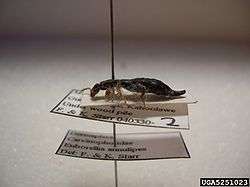Anisolabididae
| Anisolabididae Temporal range: Albian - Recent | |
|---|---|
 | |
| An adult Euborellia annulipes, or Ringlegged earwig, taken in Gunfire range, Kahoolawe, Hawaii, United States. | |
| Scientific classification | |
| Kingdom: | Animalia |
| Phylum: | Arthropoda |
| Class: | Insecta |
| Order: | Dermaptera |
| Suborder: | Forficulina |
| Family: | Anisolabididae |
| Subfamilies [1][2][3][4][5] | |
See text for genera. | |
Anisolabididae is a family of earwigs, in the suborder Forficulina and the order Dermaptera. It is one of nine families in the suborder Forficulina, and contains thirty-eight genera spread across thirteen subfamilies.
Subfamilies
Anisolabidinae
The subfamily Anisolabidinae contains twenty-five genera, cited by both Srivastava[6] and Chen & Ma.[7] Steinmann[8] in 1986, 1989, 1990, and 1993 classified the genera under the subfamilies Carcinophorinae and Gonolabiinae, which are synonyms of Anisolabidinae.[9] Other synonyms include Placolabidinae and Titanolabiinae. The genera in this subfamily are Aborolabis, Anisolabella, Anisolabis, Apolabis, Capralabis, Carcinophora, Epilabis, Epilandex, Euborellia, Flexiolabis, Foramenolabis, Gonolabis, Mongolabis, Placolabis, Gonolabina, Gonolabis, Heterolabis, Indolabis, Metalabis, Neolabis, Ornatolabis, Paraflexiolabis, Thekalabis, Titanolabis, and Zacheria.
Anophthalmolabiinae
The subfamily Anophthalmolabiinae contains one genus, Anophthalmolabis, cited by both Steinmann[8] and Srivastava.[6]
Antisolabiinae
The subfamily Antisolabiinae contains one genus, Antisolabis, cited by both Steinmann[8] and Srivastava.[6]
Brachylabinae
The subfamily Brachylabinae contains three genera: Brachylabis, Ctenisolabis, Metisolabis. Ctenisolabis and Metisolabis were cited by both Steinmann[8] and Srivastava,[6] while Brachylabis was cited by Steinmann,[8] Srivastava,[6] and Chen & Ma.[7]
Idolopsalinae
The subfamily Idolopsalinae contains one genus, Idolopsalis, cited by both Steinmann[8] and Srivastava.[6]
Isolabiinae
The subfamily Isolabiinae contains four genera: Africolabis, Geracodes, Isolabis, and Pterolabis They were cited only by Steinmann.[8]
Isolaboidinae
The subfamily Isolaboidinae contains one genus, Isolaboides, cited by only by Srivastava.[6]
Parisolabiinae
The subfamily Parisolabiinae contains two genera, Parisolabis and Parisopsalis. They were cited by both Steinmann[8] and Srivastava.[6]
Platylabiinae
The subfamily Platylabiinae contains one genus, Platylabia, cited by Steinmann,[8] Srivastava,[6] and Chen & Ma.[7]
Incertae sedis
The genus Toxolabis was described in 2014 from a single fossil male recovered from Burmese amber. The single species T. zigrasi matches that of Anisolabididae members. Unfortunately due to the quality of the preservation, the describing authors were not able to be determine a more specific placement within the family.[10]
References
- ↑ http://species.wikimedia.org/wiki/Anisolabididae
- ↑ http://www.faunaeur.org/full_results.php?id=11932
- ↑ http://www.itis.gov/servlet/SingleRpt/SingleRpt?search_topic=TSN&search_value=102460
- ↑ http://sn2000.taxonomy.nl/Taxonomicon/TaxonLinks.aspx?id=147033&syn=1[]
- ↑ http://134.60.85.50:591/Earwig_online/FMPro?-db=systematics.fp5&-format=systematicsn%5ferg.html&-lay=standard&-sortfield=select%20...&Family=Anisolabididae&-find=[]
- 1 2 3 4 5 6 7 8 9 10 11 12 13 14 15 16 17 18 Srivastava Fauna of India Pt. 2
- 1 2 3 4 5 6 Chen & Ma 2004 Fauna Sinica
- 1 2 3 4 5 6 7 8 9 10 11 12 13 14 15 Steinmann 1986, 1989, 1990, 1993
- ↑ Haas, Fabian (1996-07-18). "Dermaptera. Earwigs.". The Tree of Life Web Project. Retrieved 2009-06-21.
- ↑ Engel, MS; Grimaldi, D (2014). "New mid-Cretaceous earwigs in amber from Myanmar (Dermaptera)". Novitates Paleoentomologicae. 6: 1–16.
External links
- The Earwig Research Centre's Anisolabididae database Instructions: type Anisolabididae in the "family" field and click "search".
- A drawing of the species Titanolabis colossea